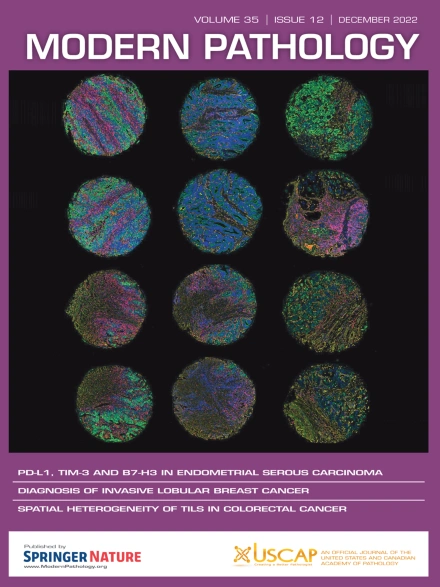与成人患者相比,儿童炎症性肠病患者的发育不良表现出不同的临床病理特征。
IF 7.1
1区 医学
Q1 PATHOLOGY
引用次数: 0
摘要
由于其罕见性,关于儿童炎症性肠病(IBD)患者的临床病理特征的信息有限。现有的针对这些患者的监测指南并未将异常增生作为结直肠癌(CRC)的潜在危险因素,并且对于检测异常增生的最佳策略也没有明确的指导。因此,我们分析了20例IBD患者的临床病理特征,这些患者在21岁之前至少出现过一次发育不良(n = 56)。然后将结果与先前发表的成人队列数据进行比较,该队列包括167名连续成年IBD患者的315例发育不良病变。该研究组由11名男性和9名女性组成,诊断为IBD时的平均年龄为11岁。研究组首次诊断为发育不良时的平均年龄为18岁,而成年组为54岁。研究组溃疡性结肠炎发生率较低(65% vs. 92%, p < 0.001),但并发原发性硬化性胆管炎(PSC)的患者比例几乎是成年组的两倍(25% vs. 13%, p = 0.129)。与成人组(分别为25%和24%)相比,研究组的发育不良更有可能是非常规的(38%,p = 0.047),不可见或扁平的(50%,p < 0.001)。高风险的非常规发育不良亚型,包括隐窝发育不良(13%,p = 0.016)、杯状细胞缺陷型发育不良(11%,p = 0.010)和高黏液性发育不良(9%,p = 0.009),在研究组中比成人组更常见(分别为4%、3%和2%)。研究组从IBD诊断到首次异常增生的平均时间(8年)明显短于成年组(16年)(p = 0.005)。虽然成年组的发育不良病变在初始诊断时更有可能表现为高级别发育不良(HGD)(研究组为17%,p = 0.008),但两组随访时晚期肿瘤(HGD或CRC)的发生率相似(成年组为26%,研究组为22%,p = 1.000)。总之,儿童IBD患者的发育不良通常与非常规特征(包括高危亚型)、不可见/扁平外观、并发PSC和早期发展(IBD诊断后8年内)相关。本文章由计算机程序翻译,如有差异,请以英文原文为准。
Dysplasia in Pediatric Patients with Inflammatory Bowel Disease Shows Distinct Clinicopathologic Features Compared With that in Adult Patients
Due to its rarity, there is limited information on the clinicopathologic features of dysplasia in pediatric patients with inflammatory bowel disease (IBD). The existing surveillance guidelines for these patients do not include dysplasia as a potential risk factor for colorectal cancer, and there is no clear guidance on the optimal strategy for detecting dysplasia. As such, we analyzed the clinicopathologic features of 20 patients with IBD who developed at least 1 instance of dysplasia (n = 56) before the age of 21 years. The results were then compared with data from a previously published adult cohort, which included 315 dysplastic lesions from 167 consecutive adult patients with IBD. The study group consisted of 11 men and 9 women, with a mean age of 11 years at the time of IBD diagnosis. The mean age at the time of the first dysplasia diagnosis was 18 years for the study group compared with 54 years for the adult group. The study group had a lower incidence of ulcerative colitis (65% vs 92% in the adult group, P < .001), but the proportion of patients with concurrent primary sclerosing cholangitis was nearly double that of the adult group (25% vs 13%, P = .129). Dysplasia in the study group was more likely to be nonconventional (38%, P = .047) and invisible or flat (50%, P < .001) compared with the adult group (25% and 24%, respectively). High-risk nonconventional dysplastic subtypes, including crypt dysplasia (13%, P = .016), goblet cell–deficient dysplasia (11%, P = .010), and hypermucinous dysplasia (9%, P = .009), were more common in the study group than in the adult group (4%, 3%, and 2%, respectively). The mean duration from IBD diagnosis to the first dysplasia diagnosis was significantly shorter in the study group (8 years) than in the adult group (16 years) (P = .005). Although dysplastic lesions in the adult group were more likely to present as high-grade dysplasia at initial diagnosis (17% vs 4% in the study group, P = .008), the rate of advanced neoplasia (high-grade dysplasia or colorectal cancer) on follow-up was similar between the 2 groups (26% in the adult group vs 22% in the study group, P = 1.000). In conclusion, dysplasia in pediatric patients with IBD is often associated with nonconventional features (including the high-risk subtypes), an invisible/flat appearance, concurrent primary sclerosing cholangitis, and early development (within 8 years of IBD diagnosis).
求助全文
通过发布文献求助,成功后即可免费获取论文全文。
去求助
来源期刊

Modern Pathology
医学-病理学
CiteScore
14.30
自引率
2.70%
发文量
174
审稿时长
18 days
期刊介绍:
Modern Pathology, an international journal under the ownership of The United States & Canadian Academy of Pathology (USCAP), serves as an authoritative platform for publishing top-tier clinical and translational research studies in pathology.
Original manuscripts are the primary focus of Modern Pathology, complemented by impactful editorials, reviews, and practice guidelines covering all facets of precision diagnostics in human pathology. The journal's scope includes advancements in molecular diagnostics and genomic classifications of diseases, breakthroughs in immune-oncology, computational science, applied bioinformatics, and digital pathology.
 求助内容:
求助内容: 应助结果提醒方式:
应助结果提醒方式:


